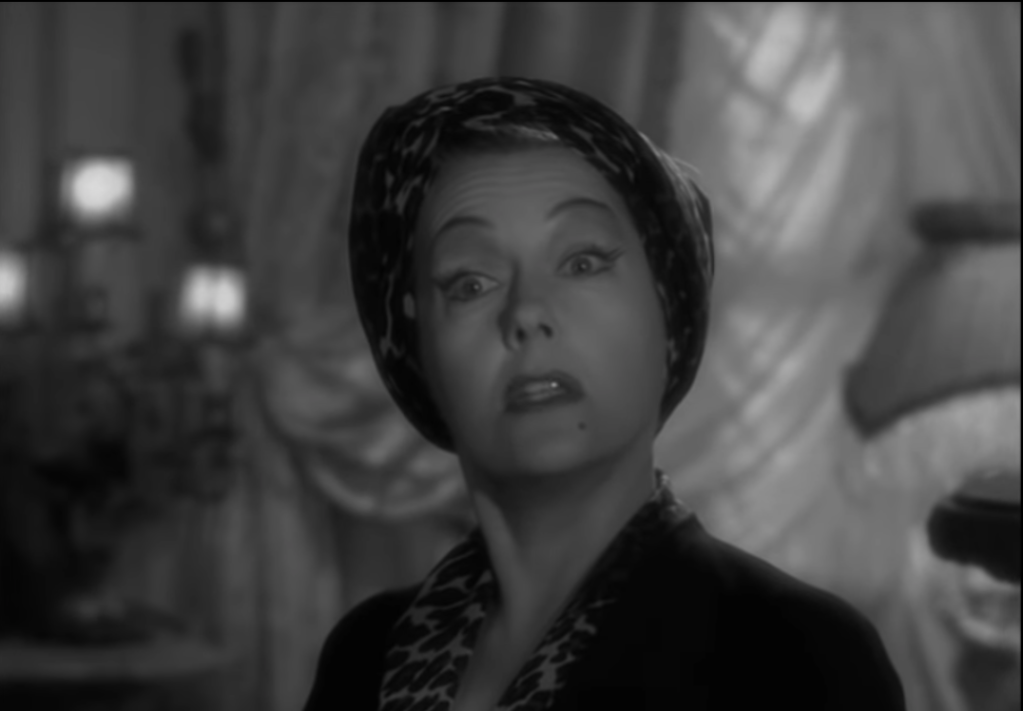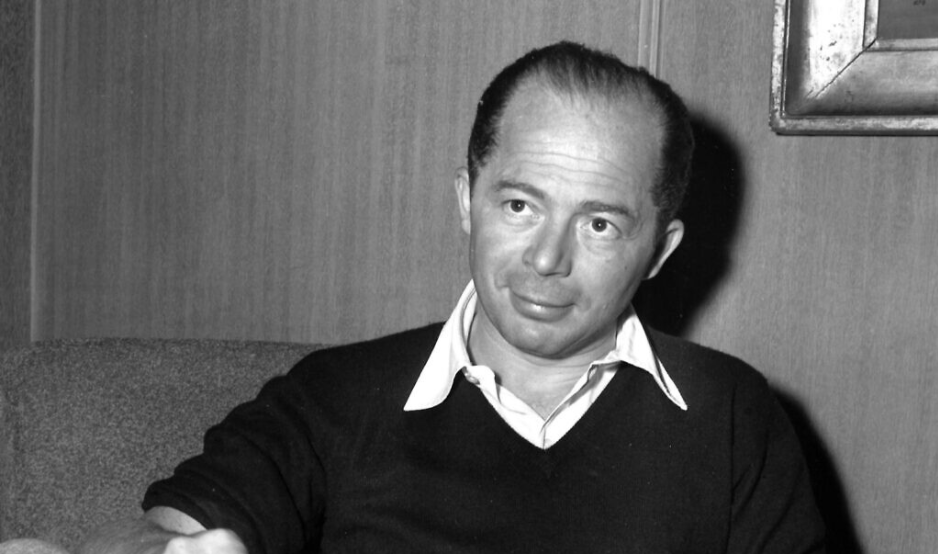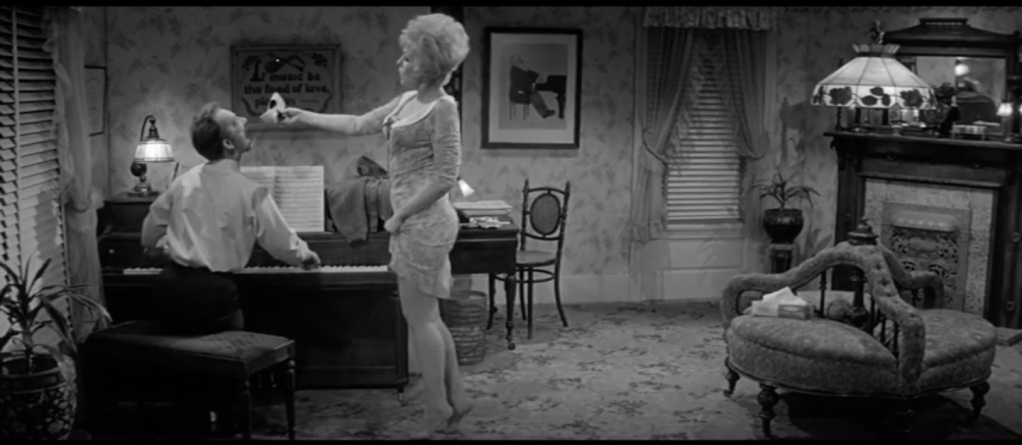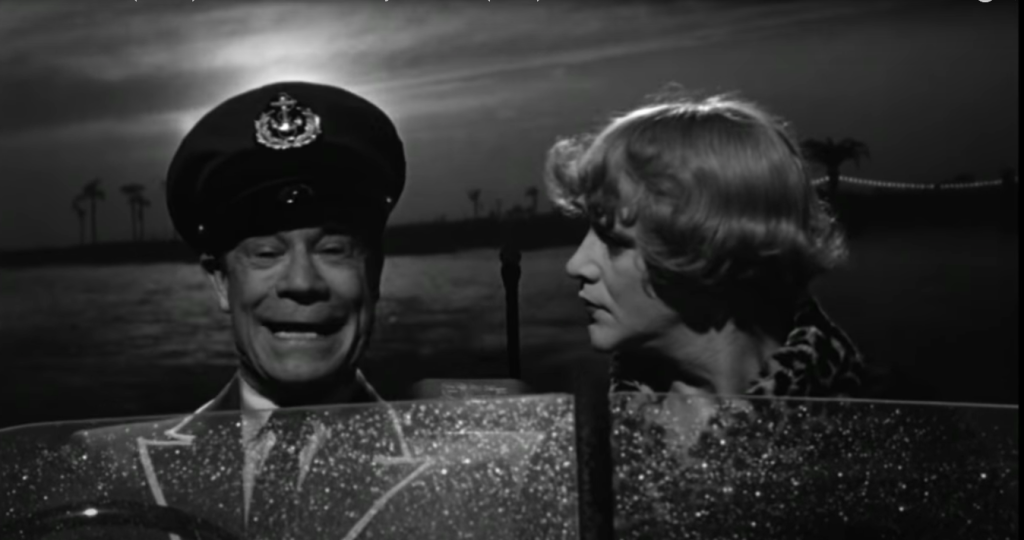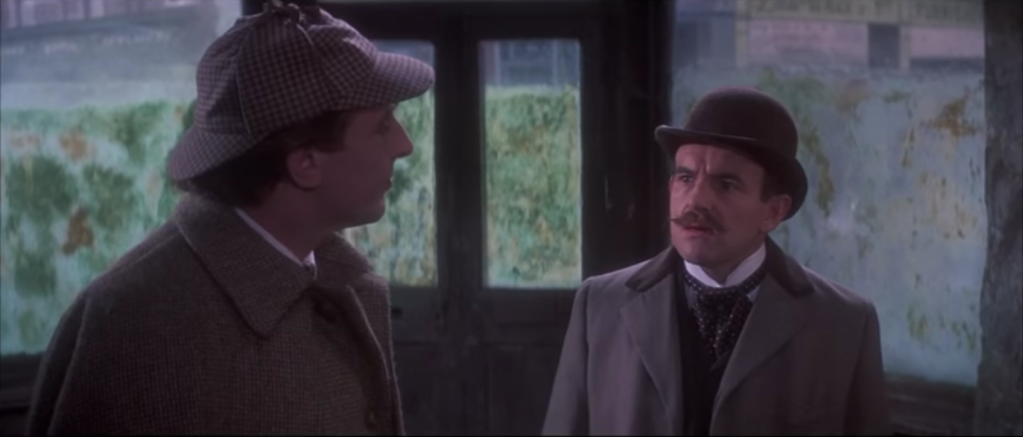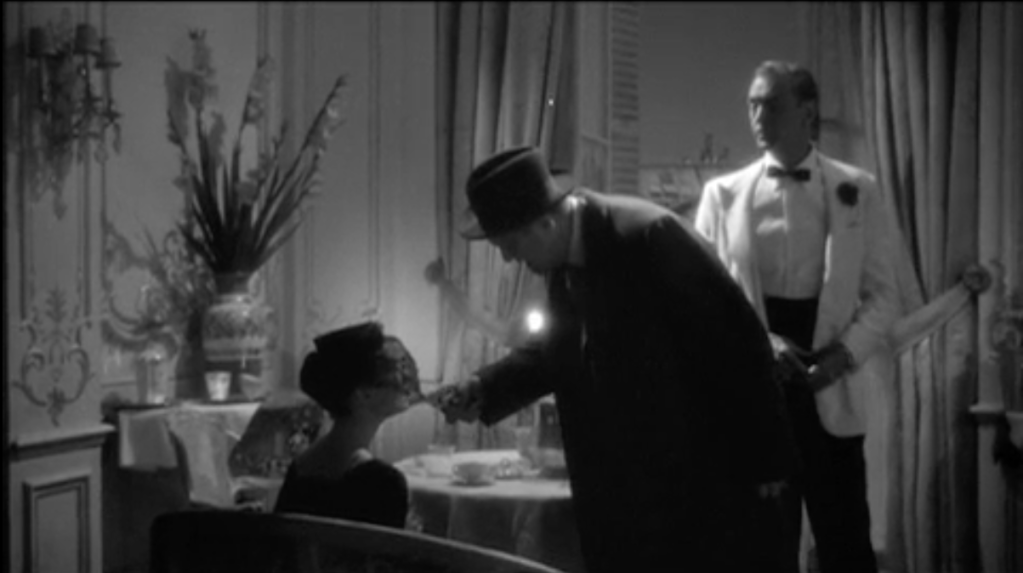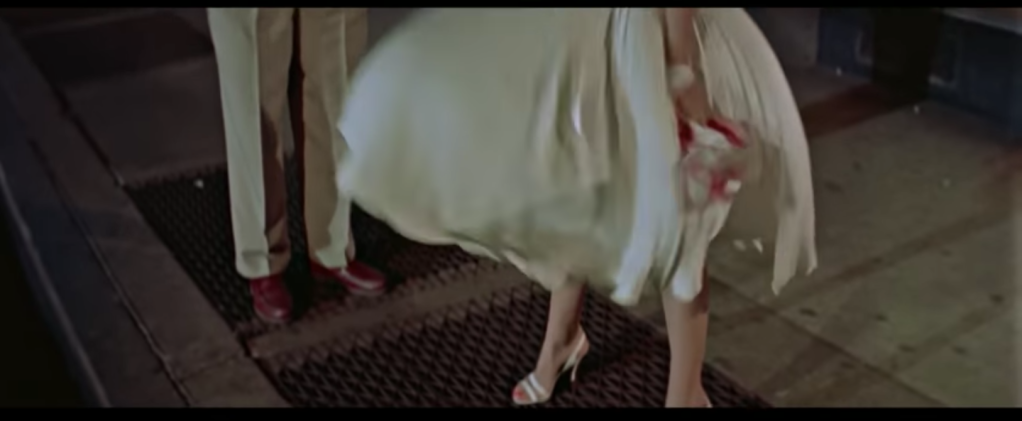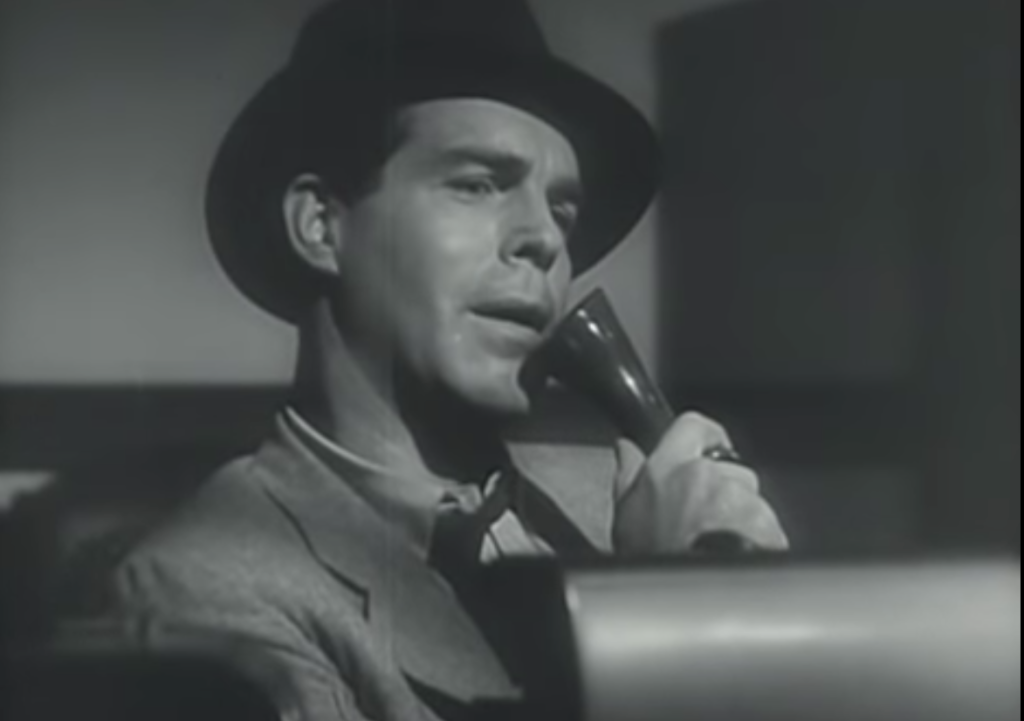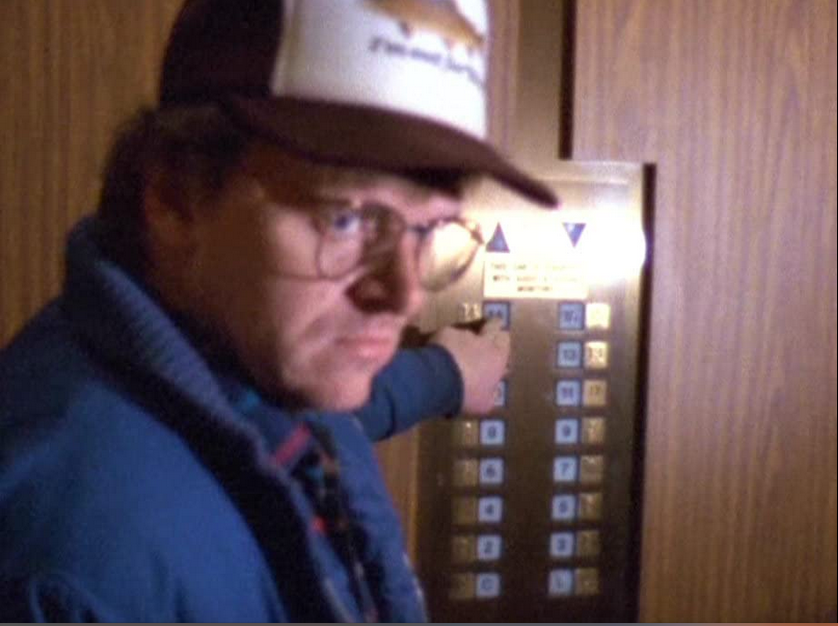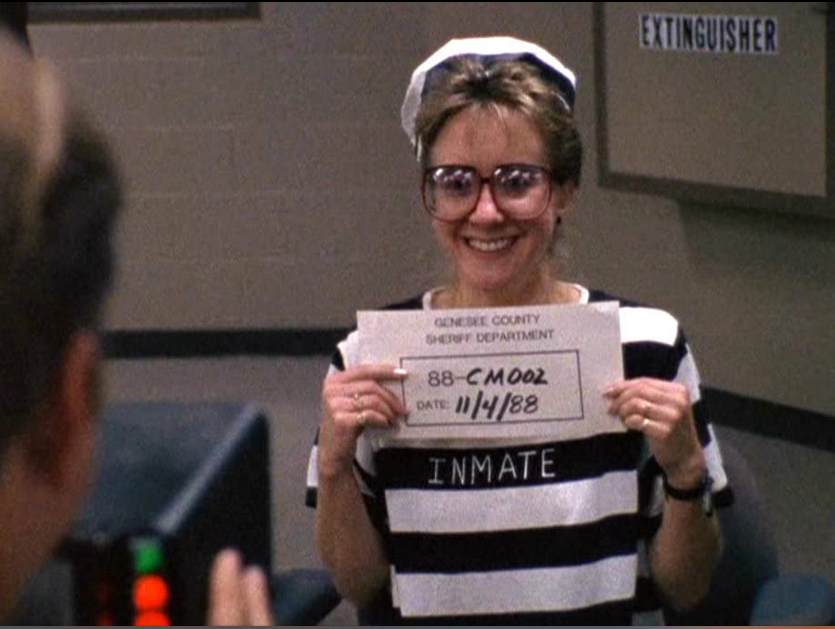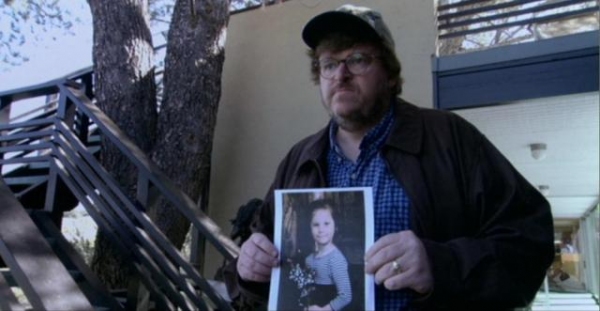Billy Wilder, 1906-2002
This was written back in 2002 for a friends’ webzine, which is now defunct. It also is one of the pieces of film criticism of which I’m proudest, a career appreciation of one of my very favorite directors.
You’re Norma Desmond. You used to be in silent pictures. You used to be big.”
“I am big. It’s the pictures that got small.”
That line from SUNSET BOULEVARD would easily be the most famous line ever penned by its scriptwriter if the scriptwriter were practically anyone besides Billy Wilder. In fact never mind Wilder’s whole ouevre — it may not even be the most famous line in the movie, which also features “All right Mr. DeMille, I’m ready for my closeup” and “We didn’t need dialogue; we had faces.” And yet ironically, the genius of SUNSET BOULEVARD contradicts that last line and its legend as an hommage to silent pictures-it’s a very “talky” picture, as if Wilder were playing a joke on his own creation by creating such a memorable line decrying dialogue.
But then, Wilder was double-edged like that. When he died this spring, the obituaries on the daily news wires knew what films were the acknowledged masterpieces to cite immediately – SOME LIKE IT HOT, THE APARTMENT, SUNSET BOULEVARD, DOUBLE INDEMNITY and usually two or three others early on, as likely as not reflecting the writer’s personal tastes. And the writers immediately picked up on Wilder’s misanthropic persona. In its first paragraph, the Associated Press obit called him an “Austrian-born cynic.” Both the AP and Reuters obits cited William Holden’s crack that Wilder had “a mind full of razor blades.” And Francophobes everywhere still treasure his assessment of France as “a country where you can’t tear the toilet paper but the currency crumbles in your hands.”
Wilder died with his reputation at its peak. He won the Academy’s Irving Thalberg Award for lifetime achievement and a similar award from the American Film Institute. When in 1998 AFI picked the 100 best American movies, four Wilder films were on the list; when it surveyed the 100 funniest American movies two years later, SOME LIKE IT HOT was No. 1. In Roger Ebert’s book The Great Movies, Wilder and Alfred Hitchcock are the only directors to have three films in it. Oscar-winning writer-director Cameron Crowe published a book-length interview with him. According to Crowe, at a 1997 Directors Guild of America symposium, the guild’s four present nominees for that year each named his greatest influences: “All agreed on only one name — Wilder.” Yet that image of Wilder as a cheap cynic, easy as it was to derive from his films and his public interviews, has clung to him, although, as Crowe’s book points out at length, it’s far too simple an image. He made some films in other veins completely, only to see them founder at the box office. Even his cynical films were never as cynical as their reputations.
Wilder’s signature narrative centers on a disguise or a con. For a Wilder character, the movie’s events involved the most important roles he ever played, as a character in WITNESS FOR THE PROSECUTION put it. Practically all of Wilder’s movies have at least a sequence (if not the whole film’s premise) involving a heretofore-decent person engaging in disguise, role-deception of some sort, or passing for somebody he isn’t in service of some scam. Of course, events always produce snowballing consequences that the scam artists don’t quite figure on — and that’s usually where the comedy and/or pathos come.
The director denied there was any autobiography in his obsession with role-playing in his movies. “That did not occur to me,” he said in his interview with Crowe. “I was not playing roles. That did not happen in my life. I was playing all the cards open.” He then, oddly, expressed a kind of gratified amazement that Crowe was asking him the question. Yet there were other too-obviously autobiographical touches repeated in his movies too often to be coincidence. For example, about half his directorial credits featured either Americans in a European setting or at least a sequence involving Germans or the use of the German language in an Anglo-American setting. Therefore, it’s hard to take seriously a total protestation against seeing Wilder’s films autobiographically and so coming to the conclusion, with Andrew Sarris, that this obsession of Wilder — an Austrian Jew who lost most of family in the Holocaust — reflects “the director’s own feelings of perpetual insecurity.”
The schemes themselves range from sweetly motivated (Lord X in IRMA LA DOUCE) and necessary (fleeing gangsters in SOME LIKE IT HOT) to petty vice (a desire to pay half-fare in THE MAJOR AND THE MINOR) and outright life and death (ACE IN THE HOLE and THE PRIVATE LIFE OF SHERLOCK HOLMES) But like in any good conman story, the films often invite a sneaking admiration for the conman’s audacity, particularly for examples as outrageous as the convoluted scams in THE FORTUNE COOKIE or KISS ME, STUPID, which involve regular Joes trying to get a piece of the pie (and a deee-luxe apart-ment … in the sky-yyy). The cons in these two films are elaborate, but they’re coming at the expense of, respectively, the NFL and its army of lawyers, and a greasy Lothario. As with the mobsters in SOME LIKE IT HOT or the newspaper-reading public as presented in ACE IN THE HOLE, there’s just no question of identifying with those whom the scam is intended to fool.
It’s hard to believe that Wilder was once considered coarse and vulgar. In his interview with Crowe, Wilder noted the furor over THE APARTMENT, in which a low-level functionary, C.C. Baxter as played by Jack Lemmon, rents out his apartment to his bosses for trysts with their lovers. It’s “a movie about the guy who climbs into the warm bed left by two lovers,” Wilder said, noting that it was called a “dirty fairy tale.” Just four years later, in 1964, the Catholic Legion of Decency went further, handing KISS ME, STUPID the scarlet C-for-condemned rating — something it had not done since 1956.
Viewed today, the movie is almost tame — the central plot involves a pathologically jealous husband who, for the sake of trying to sell a song to a womanizing Vegas lounge lizard played by Dean Martin, has to have the singer in his home. Figuring that Dino would seduce his wife, the husband hires a prostitute to play that role. One shot features a tailor’s dummy — female, correctly-shaped of course — while Dino talks frankly about his habitual conquesting; there’s a reference to Playboy when the husband feigns amorousness; and several other jokes and situations come in at that level of risqueness. The film’s third-act twist implies (though never shows) a couple of adulterous situations. Those two films would probably get a PG and a PG-13 today.
It’d be easy just to say “well that’s how far we’ve fallen,” and that wouldn’t entirely be wrong, but it would miss something important that may explain why Wilder may very well be the favorite studio-era director for my generation of cinephiles, film critics and filmmakers. I think the reason for that is that Wilder was the director who best straddled the Production Code era and its collapse. He had the craft and professionalism of the studio era without its oft-absurd comstockery of not showing toilets or having to have Lucy say she’s “expecting.” Here, in Wilder, is the director who handles bawdy subject matter and jokes about other movies (in two separate movies, he makes jokes about James Cagney’s grapefruit-smashing scene in PUBLIC ENEMY) without collapsing into AMERICAN PIE territory or pomo decadence, who shows that double entendres are most fun when they were kinda naughty — neither unspeakable nor all-too-speakable.
It was partially the times, but also Wilder’s own sensibility — he understood that understatement, implication and withholding are more essential, not less, when telling jokes about sex or other bodily functions. For example, a typical joke from 1966’s THE FORTUNE COOKIE had shyster lawyer Walter Matthau holding a metal hospital bedpan from earlier in the scene while telling the would-be-injured Lemmon “I’m handing you a quarter million dollars on a silver platter.” Nothing is said explicitly. Wilder assumes from Matthau twitching the bedpan-holding arm for emphasis that we’ll get both the immediate joke and also the implication about all the crap that the quarter-million will bring into Lemmon’s life.
As was often the case, Wilder cited his mentor Ernst Lubitsch as his model. “He realized that if you say two and two, the audience doesn’t have to be told it’s four. The audience will find it themselves; let the audience find the joke. There was always an innuendo in setting up situations, and you were rewarded by the laugh of the people who added it up,” Wilder said. (Nor was the importance of implication and discretion limited to Wilder’s direction of comic gags — witness the murder in DOUBLE INDEMNITY where all we see is a close up of Barbara Stanwyck’s face.)
Wilder’s kind of humor (however coarse in content or implication) therefore relies on a certain moralistic norm, at having social or religious restraint to play off. And that is no less true for the humor’s moral implications. For example, you could fill Norma Desmond’s swimming pool with the ink that has been expended on how SOME LIKE IT HOT supposedly deconstructs gender roles, mocked the sexual anxieties of the 50s and all that. Of course, this ignores that the film is a farce, a laugh-generating machine that relies heavily on incongruity and embarrassment for its humor. In one scene, after Lemmon’s female alter ego “Daphne” gets a marriage proposal from the millionaire Osgood, Tony Curtis asks Lemmon incredulously “why would a man want to marry a man?” Lemmon answers “security” and continues playing the maracas. I have no idea how that joke, premised on Lemmon’s missing the point of Curtis’ question, could ever work if the gay marriage folks get their way and a man can marry a man as easily as a woman. And forget about the whole last scene, where Daphne tries to weasel out of marrying Osgood, building up to a line that Ebert has called “the greatest closing line in Hollywood history.” The punch line has no punch in a world of polymorphous perversity.
Wilder’s steamroller pacing and irony-drenched plotting anticipates the cinema of the then-future (another reason his films are still as watchable as ever). But the Viennese wiseguy Wilder also had another side, and that was his love for the Lubitsch era – the fin-de-siecle world of the Victorians and continental Europe with its graceful courtliness and good-natured manners, the importance of appearance, the sexual restraint, and strong emphases on honor and dignity. Its also a world tinged with the sad regret of an era about to end and replaced with the coarsely authentic, mechanized, rational-economistic 20th century.
In interviews, Wilder constantly expressed his admiration for director-producer Lubitsch, the only influence he explicitly cited in Crowe’s interview book. Lubitsch directed Wilder’s scripts for NINOTCHKA and BLUEBEARD’S EIGHTH WIFE, and as a producer at Paramount, helped Wilder break into American films. Wilder always kept a sign in office asking “How Would Lubitsch Do It?”
But Wilder showed his romantic side and that love for the Lubitsch era and its mores in only a few films – most particularly LOVE IN THE AFTERNOON and THE PRIVATE LIFE OF SHERLOCK HOLMES. In both the former film, a rueful May-December romance from 1957, and the latter film, a melancholy detective romance released in 1970, Wilder moves the stories at a decelerated, almost glacial, rate compared to rat-a-tat-tat pacing of the comedy films he made in the intervening period. As the narrator in THE MAGNIFICENT AMBERSONS put it, “in those days, they had time for everything.”
Because it’s so unWilderesque on the surface, THE PRIVATE LIFE OF SHERLOCK HOLMES can be a baffling experience on first viewing – and it was a commercial and critical disaster in 1970. The first time I saw the movie, I was rather indifferent to it. Then an essay on the film by critic Richard Corliss in his book “Talking Pictures” made the whole film come alive in ways totally unexpected to someone expecting from the title to get a suspenseful whodunnit spiked with some juicy sexy soap opera. The film’s richly decadent romantic style and Robert Stephens’ slow, archly-fruity line readings made Wilder’s Sherlock not the first man of the 20th century but the last man of the 19th, an artist learning he is on the edge of anachronism in a world of such dishonorable cowardly methods of surreptitious warfare as spies and submarines – and this takes place a century before such advances in this field as civilian suicide bombers. Subsequent viewings have brought me more-or-less around to Corliss’ opinion that THE PRIVATE LIFE OF SHERLOCK HOLMES is Wilder’s great “late” work.
The episodic plot centers around Holmes’ gallant attempt to help a woman with no memory, Gabrielle Valladon, find her missing husband. But things are (of course) not as they seem and the parting greetings when the case is disposed of are perfectly written in the Lubitschian mode (and delivered thus by Stephens and Genevieve Page). The words are precise in their formality and are pregnant with implication about an ethereal love that can never be expressed. Nothing is said and everything is understood.
Its oblique dialogue and its “Ernstian civility and restraint [are] all the more civilized and restrained for its being made in the late 60s,” Corliss wrote. In fact, one of the most jarring lines Wilder ever wrote was Holmes’ response to Dr. Watson saying there was no need to worry about talk that the two are homosexual lovers. “I hope I’m not being presumptuous, but there have been women in your life?” Watson asks. “The answer is yes,” Holmes responds, giving Watson a second of relief before saying: “You are being presumptuous.” That exchange is impossible to imagine in today’s sincere, authentic world of openness.
In the epilogue, Holmes learns of Gabrielle’s fate and retires to his room with his cocaine. Corliss dismisses (too quickly, I think) autobiographical speculation about Wilder having come to know that he must turn away from a world that no longer wants him. But the film was a project as plainly uncommercial-for-1970 as imaginable, and Wilder never again had a major commercial and critical success.
In the Paris-set LOVE IN THE AFTERNOON, the girlish Audrey Hepburn has an name-free affair with a jaded America Lothario (Gary Cooper) who in another era would have been having his last tango. Told through layers of ironic comedy and melancholy, Hepburn saves Cooper bodily in the first half, tricking a homicidally-jealous husband, and is convinced that her innocence will rescue his heart in the second half. Her private-detective father, played by Maurice Chevalier, knows better and protects her by warding Cooper off, not via the typical Wilder comic ruse, but by a Lubitsch-like appeal to dignity and propriety. Chevalier’s persona, with its impossibly Gallic voice and his resonances from such Lubitsch films as THE LOVE PARADE, THE MERRY WIDOW and ONE HOUR WITH YOU, introduces a stoically-borne shame into Cooper that is completely Ernstian. At the end, love triumphs, but only because it has been put in its place. The narrating Chevalier, with the typical twinkle in his voice, says the couple are together and “serving a life sentence.”
Ironically, this type of happy ending prompted the other principal critical rap on Wilder for a long period – that his contemptuous misanthropy was just a pose that inevitably yielded to a hypersentimental wuss-out in the last reel. But this is to take cynical surfaces as though they defined a man to the depth of his being. Sarris was more correct than he (then) realized in his (now-recanted) charge that Wilder is “too cynical to believe his own cynicism.” Except possibly in a couple of films (A FOREIGN AFFAIR and ACE IN THE HOLE) Wilder never succumbs to his crusty exterior. His films are ultimately about opportunists who are forced by their own cynicism to find their redemption – they reach the point where they say “no more.” There are deadly consequences for those few protagonists who retain their illusions to the bitter end – Norma Desmond in SUNSET BOULEVARD and newspaperman Charles Tatum from ACE IN THE HOLE.
In THE FORTUNE COOKIE, it’s a racial slur that’s puts too much crap on the silver platter for Lemmon’s character. In THE APARTMENT, C.C. Baxter finally is forced to draw the line with his bosses when he falls in love with Fran Kubelik. THE APARTMENT is about “a nebbish who becomes a pimp who becomes a man,” Crowe said. Even in as acidic a film as KISS ME, STUPID, the nebbish husband cannot abide seeing a prostitute being treated as a prostitute and so turns on Dino and takes her in as his wife for the night. And even as frothy a film as SOME LIKE IT HOT shows a con man outgrowing his con.
From the very beginning of SOME LIKE IT HOT, Curtis’s Joe has been an effortless seducer, prompting a disbelieving to-the-camera aside from Lemmon’s Jerry as he coaxes a woman out of her car keys. Disguised as the Cary Grant-like Shell Jr. millionaire, he wins over Marilyn Monroe’s Sugar but then shortly afterward, he has to dump her. Near the end, in the garb of his female alter ego Josephine, he hears Sugar perform “I’m Through With Love.” For audiences today, knowing what we know about the Monroe legend and how it would play out shortly thereafter, the heartbreak in Monroe’s guileless and too-authentic-for-safety performance is palpable. Then Wilder redeems all his misanthropic cracks about suicide attempts and his brutalization of actresses. Curtis comes up to Monroe and kisses her passionately and says in Joe’s voice: “None of that, Sugar. No man is worth it.” The kind of critic who insists on noticing that Curtis is still dressed as Josephine and so sees covert lesbianism needs to have her critical lenses readjusted.
Besides her transcendent performance as Sugar in SOME LIKE IT HOT, Wilder also created Monroe’s signature shot – the skirt flying up from the grate in THE SEVEN-YEAR ITCH. Wilder could use Monroe to great effect for his signature sexual situation – a (usually) nerdy asexual schnook who tries to save a (usually) impossibly sexual woman.
It’s a measure of the difference in sexual personae that an ineffectual Curtis being wooed by Monroe on a boat in SOME LIKE IT HOT is one of the most famous scenes in sex-comedy history, while a near-identical scene between Lemmon’s Lord X and Shirley MacLaine in IRMA LA DOUCE is just this side of forgotten. Wilder knew that he could only get what he wanted onscreen from Monroe, despite the legendary difficulties she created during the shoot. “I’ve got an aunt who would show up every day on time, do the lines, be no trouble at all. But you know what – nobody would pay a nickel to see my aunt in this movie,” he famously said.
Wilder was probably the director most congenial to Monroe’s talents, precisely because his cynical veneer enabled him to tap into her too-innocent sexual persona – “it’s only a comedy,” people would say. Yet one of Wilder’s greatest gifts, unrelated to the scripts he wrote, was his knack for casting, for working with actors and for creating the images of some of Hollywood’s biggest stars. Wilder also shaped the screen persona of the pixie-like MacLaine with her roles in THE APARTMENT and IRMA LA DOUCE. Whenever a classy ingenue comes along today, she is following in the footsteps of Wilder’s roles for Audrey Hepburn, the adorable aristocrat (no matter her material circumstances), in SABRINA and LOVE IN THE AFTERNOON.
The most-fruitful actor-collaborator Wilder ever had was Lemmon – who made seven films with Wilder, three of them also with Matthau (including THE FORTUNE COOKIE, the pair’s first teaming). We already can see traces of Lemmon’s screen persona – the do-gooding boyish everyman with a bit of a whiny, fussy stuffed-shirt – in MISTER ROBERTS, before any of his roles for Wilder. But, like with Monroe, Wilder did better by Lemmon than any other director ever did by using him as counterpoint – putting him in a series of plots as bait for devouring by the venal schemers who populated Wilder’s films. Lemmon beautifully played off his good-natured annoyance against the sneaky Matthau’s cyclonic determination as Whiplash Willie in THE FORTUNE COOKIE and as Walter Burns in THE FRONT PAGE. Or consider the contrast in SOME LIKE IT HOT between the regular-guy Lemmon and the self-absorption of Joe E. Brown’s millionaire Osgood and the greasiness of Curtis’s womanizer.
Casting against type was another Wilder gift that seemingly came like inspiration from nowhere. He had to fight to get Ginger Rogers to portray a 12-year-old in THE MAJOR AND THE MINOR and to persuade the generally comically-genial Ray Milland to play a gritty alcoholic in THE LOST WEEKEND. The roles in both cases, again, were considered to have moral-image problems – Nabokov was still a decade away from writing LOLITA when Wilder was scripting THE MAJOR AND THE MINOR and until then alcoholic characters were generally portrayed as lovable comic types, like W.C. Fields. The results were salutary in both cases. THE MAJOR AND THE MINOR was a huge commercial success, securing Wilder’s career prospects and the latter won for Milland the first of three Oscars for Wilder thespians — the others being Holden for STALAG 17 and Matthau for THE FORTUNE COOKIE.
But Wilder’s greatest achievement in the genre of countercasting was Fred MacMurray, to whom Wilder gave his two most-memorable film roles – as the murdering lover Walter Neff in DOUBLE INDEMNITY and the lecherous boss Sheldrake in THE APARTMENT. Despite the fact these two movies were 16 years apart, at both times MacMurray had to be persuaded to abandon a solid, likable Henry Fonda-ish persona – in the early 40s based on some light screwball comedies and in the late 50s based on his deals with Disney for films like THE SHAGGY DOG and THE ABSENT-MINDED PROFESSOR and the TV show MY THREE SONS. Yet, MacMurray’s likableness is the key to the characterizations’ working. In DOUBLE INDEMNITY, it makes his corruption by Stanwyck more darkly threatening and makes his partner Edward G. Robinson’s puzzlement more explicable (as in THE PRIVATE LIFE OF SHERLOCK HOLMES, a criminal can hide most easily by being someone the detective loves). In THE APARTMENT, it makes it all the easier to believe a decent man like C.C. Baxter would rent out his room – to another decent man who just wants to be his friend and help him at work. As “your affectionate uncle Screwtape” advises Wormwood, the devil can only succeed if he appears in an attractive guise.
Wilder even had a knack for getting “good” performances from bad actors. He was able to use Dean Martin in KISS ME STUPID, basically by having him play a Vegas singer who made jokes about his drinking and womanizing during his songs and was headed out to L.A. to make a movie with Sinatra, Sammy and Joey Bishop. His character was named “Dino” in case anyone missed the point. After the end of her collaboration with director Josef Von Sternberg, Marlene Dietrich’s legend had become too great for her to credibly play a character – most of her late roles drowned in all her Marlene-ness and its self-conscious artifice. Yet Wilder was able to put Dietrich’s mannered Germanic hauteur to good use twice – in A FOREIGN AFFAIR and WITNESS FOR THE PROSECUTION. In the latter film, a better naturalistic actress than Dietrich could not have conveyed the fact that Christine Vole was in practically every scene in the movie … acting. Sizing up Charles Laughton in his office (as he is sizing up her), baiting the trap with her testimony, the cockney barmaid, her anger at her exposure and then revealing all to Laughton at the end with all the puffed-out pride in performance of Hercule Poirot fingering the killer to a roomful of suspects in the last scene. “I never played a more important role,” Christine says.
Playing roles – it always comes back to that with Wilder. It’s hard to tell whether Wilder ever really had an on-screen persona in his films. The sardonic story-telling character of Moustache in IRMA LA DOUCE may have been as close as it got. Most of his other narrators were telling their own stories, while Moustache is more like a ringmaster choreographing the fates of others. Wilder wanted to get Laughton, the actor he most admired, to play the role, but Laughton’s death prevented that dream casting. Moustache also was an emigre (from Eastern Europe to France admittedly) who tried not-wholly-successfully to blend in, but always had one more story to tell. To near the end of his days, Wilder insisted he could have made more films had he been able to win financial backing. But now, with his death, that’s another story.
Wilder is big, only now the pictures have gotten a little smaller.
Michael Moore becomes a jerk
… or how I learned to start worrying and loathe the bombast.
(Like my previous post on DOGVILLE, this was written back in 2003-04 for the webzine of two friends, Zach and Gabe, the now defunct 24 FPS. It began in response to demands on a film-discussion board that, given his skepticism of BOWLING FOR COLUMBINE, this reactionary “better explain” why he had ROGER & ME as his #1 film of 1989.)
One of the first film reviews I wrote in college called ROGER & ME (premature blurb-whoring) “the funniest and best film of the year.” Along with JFK, DO THE RIGHT THING, and THE TRAVELING PLAYERS, it’s one of the standard litany of “lefty but I love them” movies that I can cite as a politically conservative film buff. But I hadn’t seen ROGER & ME for a decade, and director Michael Moore’s subsequent work on TV NATION, THE BIG ONE and his latest, BOWLING FOR COLUMBINE, was pretty uneven. The later works had their moments, but as a whole I didn’t much care for them – though I didn’t outright hate them nearly as much as my more-liberal film-buff pals thought (quite reasonably I hasten to add).
So, a couple of nights ago, I re-watched ROGER & ME just to see if it held up or whether was I on crack in 1989. There was no way the film could make me laugh as hard as it did when I saw it at the time. It made such a strong impression on me that I still remembered all the jokes, and part of the fun I had at ROGER & ME was that I had never then seen anything quite like it – a comic, satirical documentary. I’ve seen a lot of movies like that since (a couple of non-Moore films even modeled on ROGER & ME). So the film didn’t have the same impact, I guess, but it didn’t decline in my esteem. And even if I were to have seen it for the first time yesterday, it would not have annoyed me like Moore’s recent work does for some formal and content reasons that add up to “Moore isn’t the overbearing jerk he is in his recent films.”
For example, his outsized “gonzo-wacky telling-truth-to-power” persona doesn’t yet exist in ROGER & ME, he’s more of a regular guy. During the film’s “find Roger” segments, where he’s trying to get an interview with General Motors chairman Roger Smith, there is nothing as obviously scripted and rehearsed as, e.g. the photo-op checks to pay Mexican workers and the “Downsizer of the Year” awards he gives in THE BIG ONE. As a result, there’s none of the “bully” factor that makes so grating some of Moore’s hits on corporate flacks. These “find Roger” segments in ROGER & ME are also just about the only scenes in the film where Moore is actually onscreen and the center of attention, but he doesn’t hog it. He’s playing a befuddled everyjournalist just trying to get an interview. My favorite moment was when he went into an elevator at GM headquarters and tries to hit the button for the top floor where Roger’s headquarters are – like he’s too naive to know better. Never in the earlier film does Moore play to the camera, like when he hugs those book-store employees in THE BIG ONE or the sobbing teacher in BOWLING FOR COLUMBINE.
Moore is also more tactful in the other two types of scenes in ROGER & ME – in the segments about how Flint is coping with the layoffs, he is rarely on-camera and always at its edge when he is; in the direct interview segments, he is never on-camera and sometimes even eschews being an offscreen voice. In fact, the best sequences in BOWLING FOR COLUMBINE are the interviews with Marilyn Manson and Matt Stone, who are given the opportunity to say something without Moore getting in the way. Stone in particular has some interesting points to make about the falsely deterministic “this will decide the rest of your life” pressure in high schools. In ROGER & ME, even though Moore makes brutal fun of the chipper Chamber of Commerce flack extolling Flint as a tourism mecca, it’s funny because the guy is making himself ridiculous, saying more than he intends to. With Moore onscreen, it would have come across that Moore was making a schmuck out of him (although I now realize that several of those scenes were probably pre-existing footage).
ROGER & ME does have copious voiceover, which makes his views on the material crystal-clear, but it seems less intrusive than Moore actually appearing on camera. And he sometimes even eschews voiceover and lets the subject material speak for itself, even for comic-goofy effect. He just asks, for example, the ladies at the golf club what people should do about the layoffs, and they come across as boorish snobs without a word from him. And he says nothing while all the upper-class people cavort around the city’s new jail at the pre-opening-night party. He sets up the situation and watches it. Again, contrast that to BOWLING FOR COLUMBINE where he makes an open, caustic attack on welfare-work requirements as “making fudge for rich people.” This level of bitter explicitness invites others (well, at least me) to wonder whether the mother of a 6-year-old who committed a Flint school shooting (the occasion for Moore’s rant) would have been less unavailable if the state required her to be “making fudge for poor people” or even “making gruel for poor people” or even if she had an 8-hour-a-day private-sector job doing whatever. Never is there a line in ROGER & ME after the jail’s opening night like “the next night, the inmates were there and things were rather less light.” Latter-day Moore would not have resisted that.
In a similar vein, there are lengthy segments in both ROGER & ME and BOWLING FOR COLUMBINE set to ironic counterpoint music and they also illustrate the major difference in content between the two films – the earlier film is about one thing that Moore understands (the devastation of his hometown by GM layoffs); the latter is about anything and everything, and on much of which Moore simply doesn’t know what he’s talking about. In ROGER & ME, there’s a lengthy drive through Flint’s slums set to the Beach Boys “Wouldn’t It Be Nice.” It could have come across as cheap, but it follows a scene where an auto worker, whom Moore had put on the cover of Mother Jones, describes his last day at work, when he had a mental breakdown on the job and then he turned on his car radio and that song was playing. In other words, the juxtaposition isn’t simply Moore grabbing for an easy effect. And its link to a guy who’s in a mental home puts us in his mind and makes it kinda poignant (as well as sarcastic and angry). In BOWLING FOR COLUMBINE, the comparable scene is a scroll of U.S. foreign-policy actions set to Louis Armstrong’s “What a Wonderful World.” It comes across as annoyingly self-righteous, not simply because of the tendentious and sometimes laughable descriptions of U.S. foreign policy (I could quarrel with the majority of them in one or another way), but also because of the too-cheap irony of the song is coming from nowhere.
And even apart from that, Moore is positing an argument that simply doesn’t make a lick of sense or stand up to a second’s scrutiny. He’s trying to make some point to the effect that the Columbine shooters were inspired by the Lockheed missile factory in the town. But where then are the defense-contractors in such school-shooting venues as West Paducah, Ky., Jonesboro, Ark., or Pearl, Miss.? I went to a high school whose district lines jutted an Air Force base and was in a metro area with two additional Air Force bases and one Army base. There hasn’t been a single school shooting in the San Antonio area to my knowledge. In contrast, with ROGER & ME the link between job layoffs and local economic depressions and their subsequent effects (the rats outnumber the people because garbage pickups get cut back) is rather clear. In the “Wouldn’t It Be Nice” scene, all Moore does is show the effects of a local depression and that’s enough.
Not that BOWLING for COLUMBINE is worthless or doesn’t have some sharp things to say. It doesn’t take the easy route and claim, as gun controllers are wont, that gun deaths in the United States are a simple function of gun numbers or availability. Instead, Moore comes down harder on the “if it bleeds, it leads” mentality of news coverage, particularly of local news, TV news and reality TV. This diet of bloody images has caused people to think that violence and mayhem are much more routine than they in fact are. This resulting mentality stifles community and poisons ordinary interaction and so puts the country on a “gotta have a gun/shoot first” hair-trigger and creates a self-fulfilling prophecy. But even when his film is making that interesting point, Moore pushes it too hard in a desire to bash capitalism. He blames the coverage on a desire for ratings and profits, but this merely raises a further question that Moore doesn’t answer – why does gore and mayhem produce the ratings and profits in the first place? Again, as throughout his later, more ambitious, but more-scattershot and far less-satisfying films, Moore trips over his press clippings while his reach is exceeding his grasp.
Dogville: A hell of a movie
This was written back in 2004 for a friends’ webzine, which is now defunct. It is honestly one of the pieces of film criticism of which I’m proudest and for one of my very favorite contemporary films. And there are spoilers aplenty for the whole movie.
DOGVILLE (Lars Von Trier, Denmark, 2004) 10
The Gospel of St. Matthew has the following passage (11:20-24):
Then began he to upbraid the cities wherein were done the most of his miracles, for that they had not done penance. ‘Woe thee, Corozain, woe to thee, Bethsaida: for if in Tyre and Sidon had been wrought the miracles that have been wrought in you, they had long ago done penance in sackcloth and ashes. But I say unto you, it shall be more tolerable for Tyre and Sidon in the day of judgment, than for you. And thou Capharnaum, shalt thou be exalted up to heaven? Thou shalt go down even unto hell. For if in Sodom had been wrought the miracles that have been wrought in thee, perhaps it had remained unto this day. But I say unto you, that it shall be more tolerable for the land of Sodom in the day of judgment than for thee’.
Lars Von Trier’s DOGVILLE is about that passage. And it is not subtle – Nicole Kidman’s character is named Grace. And Grace is rejected by the town. And the rejection of Grace brings damnation.
DOGVILLE was widely derided by the U.S. press at the Cannes festival in May on very different and more-prosaic grounds – as an anti-American rant by an ignorant European who had never been here. Todd McCarthy closed his Variety review by saying that “Von Trier indicts as being unfit to inhabit the earth a country that has surely attracted, and given opportunity to, more people onto its shores than any other in the history of the world. Go figure.” You don’t necessarily have to have read the press book (though McCarthy and others did quote Von Trier from it liberally) to come to that conclusion. The vast 175-minute body of the film portrays the reaction of the residents of Dogville to the arrival of the stranger from Nowhere, and her involvement and eventual estrangement from the town. It’s easy to see how the usual suspects would interpret this in all sorts of ways about how mean we are to immigrants (it’s why they’re beating down the doors to get in – “please oppress us.”)
I submit that DOGVILLE makes more sense and is meatier when seen as a religious film rather than a political one, the unfortunately crude and literal closing credits notwithstanding. But as a religious work of art, DOGVILLE is a rare breed today – unapologetically moralistic, and displaying and justifying the most unpopular Christian doctrine of all – Hell.
Von Trier may be his own worst enemy in inviting people to see the film as a political manifesto, saying among other things, to McCarthy’s gleeful citation that “I don’t see (Americans) as less evil than the bandit states.” But the anti-American Americans (think Noam Chomsky or Susan Sontag) who might be expected to lap up this film will see an uncomfortable portrait of themselves in the character of Tom Edison, played by Paul Bettany as a man who conceives of himself as apart from the rest of the town in his relationship to Grace, as if he’s the judge and assessor of the town’s virtues and vices. He proves not to be quite so worthy as to cast the first stone.
Unfortunately (or maybe “propitiously”), DOGVILLE’s central stylistic trope, its being performed on an “Our Town”-style stage where chalk outlines define the houses and streets and there are only a few props, makes it too unspecific to be convincing as a national portrait. DANCER IN THE DARK (2000) had the same “problem” – while clearly and specifically set in the United States, it really belonged in the world of movie melodramas and worked like gangbusters as a weepie. Looking at DANCER for a political critique would be like watching TOP HAT for information about Venice, rather than for Fred Astaire and Ginger Rogers dancing. In the same way, the main body of DOGVILLE is so stylized, not so much general and unspecific as defiantly anti-specific (it literally screams “artificial set” at every instant), that it’s impossible to take seriously in realistic terms as social criticism. John Hurt’s narration has a Masterpiece Theater British-literary formality that is totally alien to any portrait of America. The film’s only credited score uses Antonio Vivaldi’s “Nisi Dominus,” which, apart from the anti-realistic anachronism, is also the Latin Vulgate name for Psalm 126. The title means “unless the Lord” and the Psalm opens “Unless the Lord build the house, they labor in vain that build it; Unless the Lord keep the city, he watcheth in vain that keepeth it.” And Dogville is about a city that the Lord didn’t keep. Or rather, it didn’t keep the Lord.
The film specifically sets itself up as having a God-like point-of-view and hammers that home 50 ways to Sunday. The title cards are providential, telling the viewer what will happen before it does: “Tom hears gunfire and meets Grace”; “Grace indulges in a shady piece of provocation.” The opening shot is literally a God-like POV: it descends from a height and looks down upon the town and its chalk outlines. Von Trier repeats that shot at other times for emphasis – such as when Grace hides in an apple truck to flee the town. Not only does Hurt play an omniscient narrator, but his vocal reciting is God-like as well – avuncular, out-of-time and -place, objective, and absolutely serene and knowing. The wall-less, roof-less sets mean that everything is visible at all times (an especially important device for framing the first rape of Grace). “The eyes of God see all,” as the Woody Allen of CRIMES AND MISDEMEANORS might put it. Even the attempts to cover up and hide can’t escape God’s penetrating glance – again the apple-cart shot, when Grace pulls a tarp over herself. But we from above still see her, the tarp only as opaque as a nylon stocking.
If Grace is her name in a stylized, unspecific world overseen by a providential God-like narrator, then She becomes a theological signifier – of grace, an eternally suffering servant – and thus of Christ. And what are the consequences of rejecting the saving grace of Christ, as the townspeople reject Grace? Damnation, according to every Christian denomination that claims such a thing is possible and knowable, including Von Trier’s Catholic Church. The relevant scene is near the end (or The End, as it were) between Grace and her father, played by James Caan, who has come to rescue her from the abuse she has been suffering at the hands of the townspeople. Grace begins the conversation wanting to save them, but the father talks her out of it on the basis of the necessity for judgment. It’s not that we have to stand on one side or the other, it’s more that because both Father and Son are part of the same Godhead, both justice and mercy have to come on the same side, otherwise you have gangsterism (the Father alone) or victimology (the Son alone).
This scene could not be more clearly coded as theology and as the logical moral result of the first 160 minutes – it’s the Christ-figure’s father bringing an end to the providential narrative and doing so by having Her judge all according to how they treated Her. Von Trier is nothing if not explicit. That’s why it’s essential that when Grace destroys the town, she recites back at a character some lines about her children before she actually kills them, rhyming with Jesus’ saying what he’d say to those he’d cast to Hell. Is murdering children in front of their mother hellish? Sure, but that’s why the rejection of God’s Grace is called “Hell.” Jesus could not have been more explicit in the New Testament about this being what He will do on Judgment Day – judge all according to how they have treated Him. The key lines from Caan are that “people’s best isn’t good enough” (salvifically-speaking, this is what Christianity has always taught about the Kingdom of Heaven; it’s nothing we can just achieve through work). And the Father says that even a dog won’t learn if all you do is forgive, and that it is demeaning and infantilizing not to hold people accountable. Since all the townspeople are shown as unrepentant sinners, and continually reject and spit on Grace, they choose their own damnation. These people are merely reaping what they sowed; they have damned themselves. And that’s more or less what happens at the end – everyone is murdered by the father’s hitmen/angels and the town is even symbolically burned down (fire, flames… Hell. As I say, Von Trier is not subtle.)
What DOGVILLE represents in Von Trier’s overall oeuvre is the flip side of his “Golden-Heart” trilogy. In BREAKING THE WAVES (1996), THE IDIOTS (1998) and DANCER IN THE DARK, whatever their differences, his heroines were Christ-figures who went through a kind of hell, the tortures of the damned. The primary difference in the narrative among the three earlier films rests on what Bess, Selma and Karen achieve from being put through the wringer – Resurrection and Exaltation (WAVES); self-sacrifice for family (DANCER); and not much, a redundant kind of self-knowledge at best (IDIOTS). This recurrent theme of female victimhood has been one of the main critical raps on Von Trier for the past decade, that he basically “gets off on suffering chicks”. Or as McCarthy put it: “Whereas von Trier in his recent ‘Golden-Heart’ trilogy has led his heroines through an earthly hell to achieve a state of grace, he is determined to have his central character here show no mercy when it comes to punishing her tormentors. Grace is given the position of an all-powerful god, dispensing a Sodom and Gomorrah-like judgment on those among whom she formerly dwelled.”
I’m becoming more firmly convinced that Von Trier made DOGVILLE as an answer to those charges of sexism: “Oh … you don’t like characters who suffer nobly to the end. Well, here’s the alternative.” No longer is the Von Trier female heroine a Suffering Servant; now she turns from all-forgiving Christ-figure to avenging angel when she realizes that forgiveness without judgment is indulgence and infantilizing. One of the reasons DOGVILLE can only end as it does, and which many people will and do hate it for but which is precisely the reason the film is so gloriously out-of-step theologically, is because the whole first 160 minutes shows how deeply problematic is a doctrine of unlimited, ever-patient grace, a Son with no Father, a salvation with no damnation. The shallowest, but most-popular way in Our Very Enlightened Time of understanding the New Testament (Jesus as all-‘luvving’), causes enormous problems with DOGVILLE: “How could a Christ-figure turn vengeful?” If you felt any ambivalence toward Grace in the main flow of the story, any part of you saying “stop being such a patsy,” then there has to be sort of hell at the end. Otherwise, she’s just an object of pity.
The end of DOGVILLE and the “turn” in Grace’s character shouldn’t trouble anyone with a firm grasp of the Bible, Christian theology and Christian history. Or rather it should not trouble him any more than Christianity itself does. Even viewing the Bible as secular literature shows the impossibility of a radical dichotomy, such as McCarthy makes (he also accuses DOGVILLE of reflecting “his new Old Testament view of the world”). There’s certainly differing rhetorical weights, but both elements, justice and forgiveness, are in both testaments. The moral task DOGVILLE calls forth from the viewer is to be able to conceive of both justice and forgiveness, desert and grace, in terms that don’t require them to contradict, as the popular Old Testament/New Testament, Christ/avenging-angel dichotomies must.
But the puckish Von Trier can’t resist for a walk-off a theological in-joke that becomes funnier the more you’ve been following the Catholic Church’s inter-religious dialogue under John Paul II. There’s one loose end at DOGVILLE’s Apocalypse – the dog, a Rottweiler. It’s subtly named “Moses” and after the town has been destroyed, Moses is the only survivor. The camera takes the God-like overhead POV and pulls back as Moses barks. Hurt’s voice-of-God narration tells the viewer that he may have been asking himself what happened to Moses. “That will not be answered here.”
